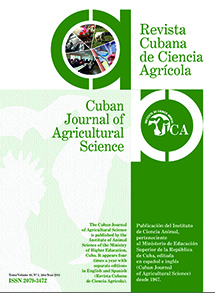The performance, haematological indices and serum chemistry of two breeds of broiler chickens fed Ficus exasperate leaf powder and Vitamin C supplemented diets
Contenido principal del artículo
Resumen
A total of 240 Arbor acre (AB) and 240 Cobb 500 (CO) broiler chickens given Ficus exasperate leaf powder (1%FELP) and 200mg/kg Vitamin C (VC) supplemented diets were studied for performance and blood indices. Diets 1 and 2 (controls) were fed to AB and CO, respectively; Diets 3 and 4 (VC supplemented) were fed to AB and CO, respectively; Diets 5 and 6 (FELP supplemented) were fed to AB and CO, respectively; while diets 7 and 8 (VC+FELP supplemented) were fed to AB and CO, respectively. At 6 age weeks, body weight gain (BWG) of CO improved (P<0.05) over the AB birds, while VC improved BWG of CO over AB. VC improved the feed conversion ratio (FCR). VC and FEPL increased the packed cell volume and the red blood cell (RBC); while the RBC of CO was higher (P<0.05) than AB. The VC and FELP increased the haemoglobin concentration. The white blood cell count improved (P<0.05) by FELP. The VC and VC x FELP reduced (P<0.05) the serum aspartate aminotransferase concentration. VC and FELP reduced (P<0.05) the serum creatinine concentration. The FELP reduces (P<0.05) the serum cholesterol. Conclusively, CO and 200 mg/kg Vitamin C supplementation support optimal body weight gain. For better immunity and hypocholesterolemia, 1 % FELP supplementation is indicated; while 1 % FELP might be coupled with 200 mg/kg Vitamin C to enhance feed consumption, red blood cell count, packed cell volume, haemoglobin concentration; to prevent liver and tissue damage and protect renal cells from damage in broiler chickens.
Key words: avian; genetic make-up; phytogens; citric acid; stress.
Key words: avian; genetic make-up; phytogens; citric acid; stress.
Detalles del artículo
Cómo citar
Osowe, C. O., Adu, O. A., Oloruntola, O. D., & Chineke, C. A. (2023). The performance, haematological indices and serum chemistry of two breeds of broiler chickens fed Ficus exasperate leaf powder and Vitamin C supplemented diets. Cuban Journal of Agricultural Science, 56(4). Recuperado a partir de https://mail.cjascience.com/index.php/CJAS/article/view/1064
Sección
Ciencia Animal
Aquellos autores/as que tengan publicaciones con esta revista, aceptan los términos siguientes:
- Los autores/as conservarán sus derechos de autor y garantizarán a la revista el derecho de primera publicación de su obra, el cuál estará simultáneamente sujeto a la Licencia Creative Commons Attribution-NonCommercial 4.0 International (CC BY-NC 4.0) que permite a terceros compartir la obra siempre que se indique su autor y su primera publicación esta revista. Bajo esta licencia el autor será libre de:
- Compartir — copiar y redistribuir el material en cualquier medio o formato
- Adaptar — remezclar, transformar y crear a partir del material
- El licenciador no puede revocar estas libertades mientras cumpla con los términos de la licencia
Bajo las siguientes condiciones:
- Reconocimiento — Debe reconocer adecuadamente la autoría, proporcionar un enlace a la licencia e indicar si se han realizado cambios. Puede hacerlo de cualquier manera razonable, pero no de una manera que sugiera que tiene el apoyo del licenciador o lo recibe por el uso que hace.
- NoComercial — No puede utilizar el material para una finalidad comercial.
- No hay restricciones adicionales — No puede aplicar términos legales o medidas tecnológicas que legalmente restrinjan realizar aquello que la licencia permite.
- Los autores/as podrán adoptar otros acuerdos de licencia no exclusiva de distribución de la versión de la obra publicada (p. ej.: depositarla en un archivo telemático institucional o publicarla en un volumen monográfico) siempre que se indique la publicación inicial en esta revista.
- Se permite y recomienda a los autores/as difundir su obra a través de Internet (p. ej.: en archivos telemáticos institucionales o en su página web) antes y durante el proceso de envío, lo cual puede producir intercambios interesantes y aumentar las citas de la obra publicada. (Véase El efecto del acceso abierto).
